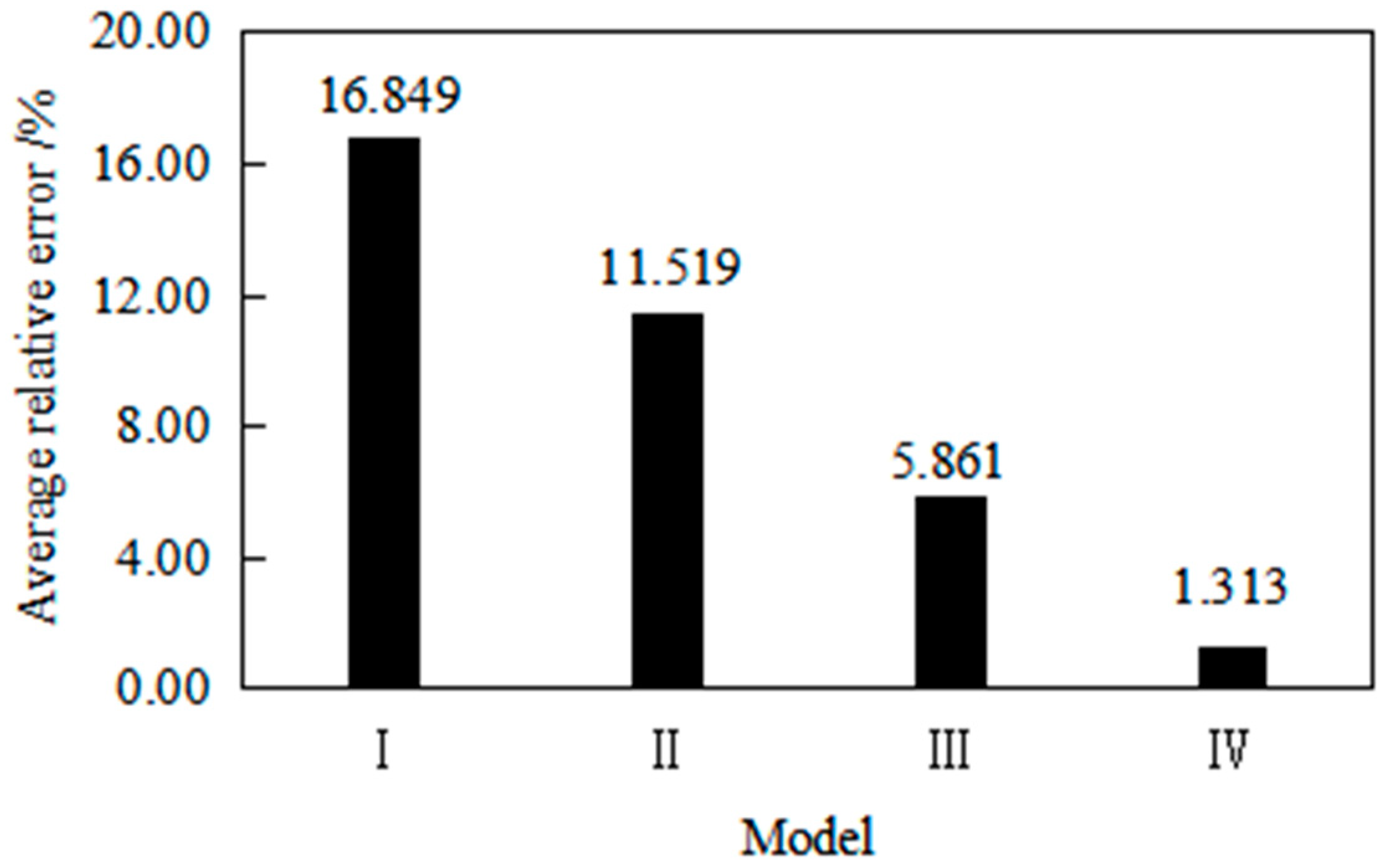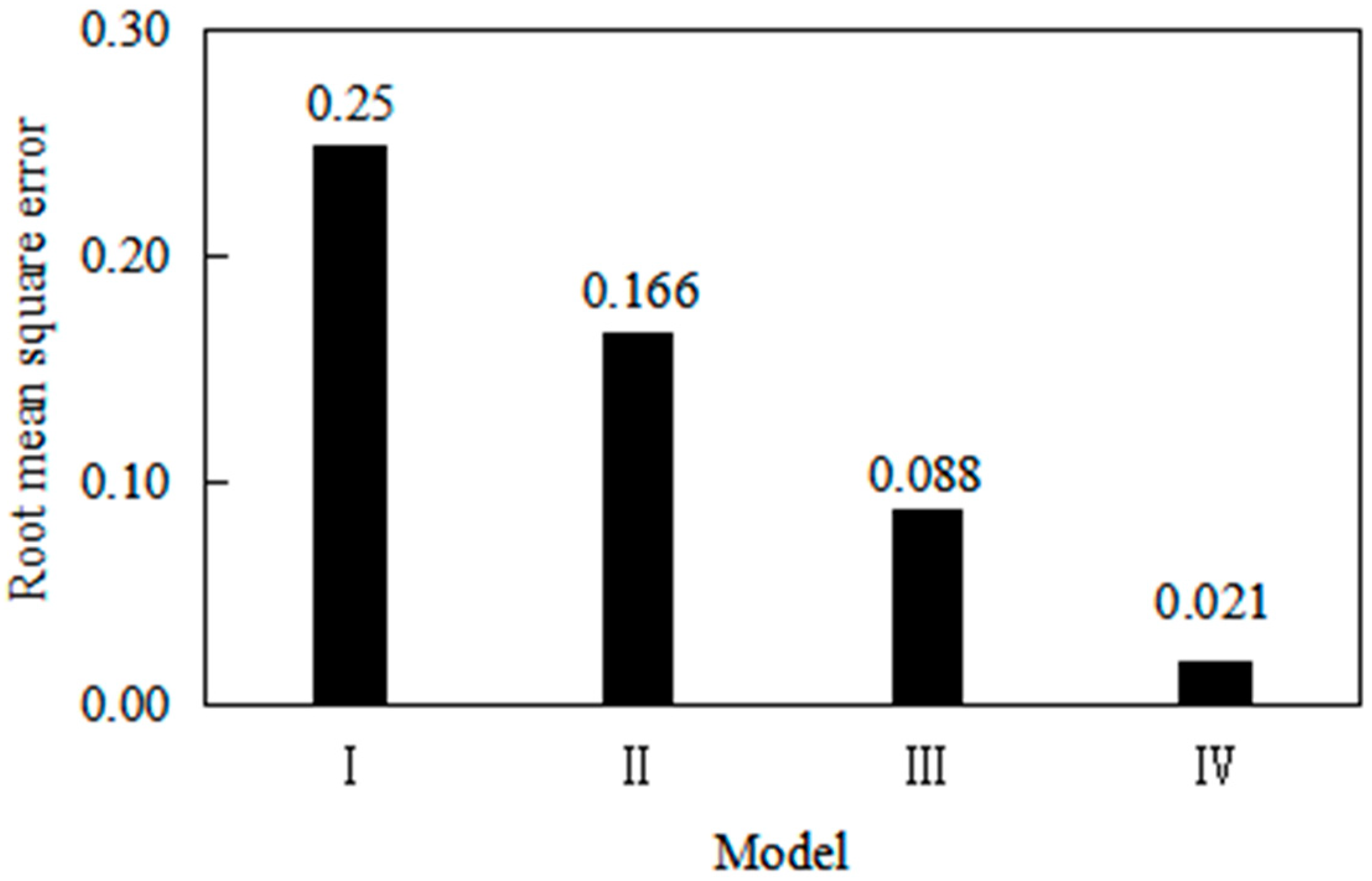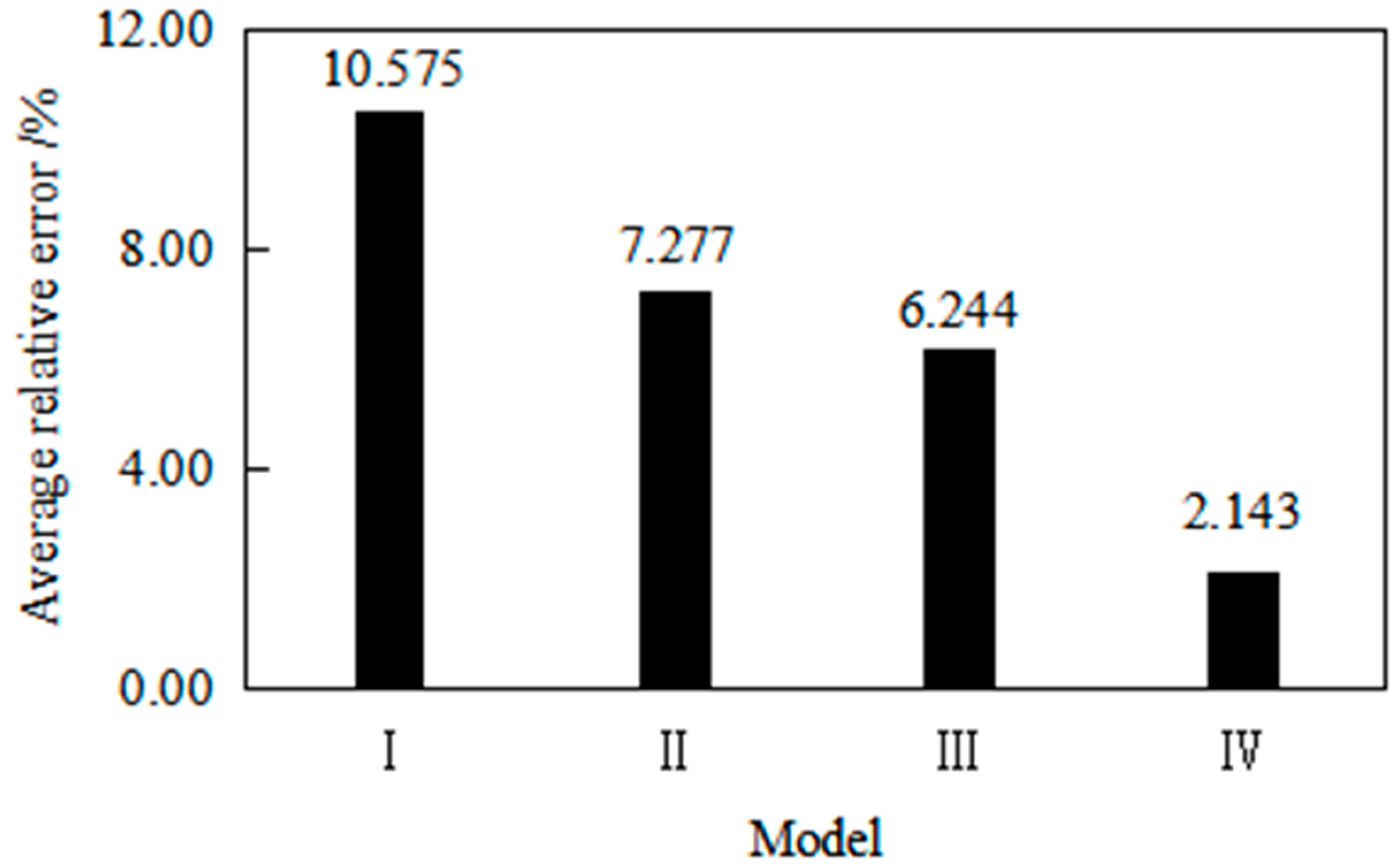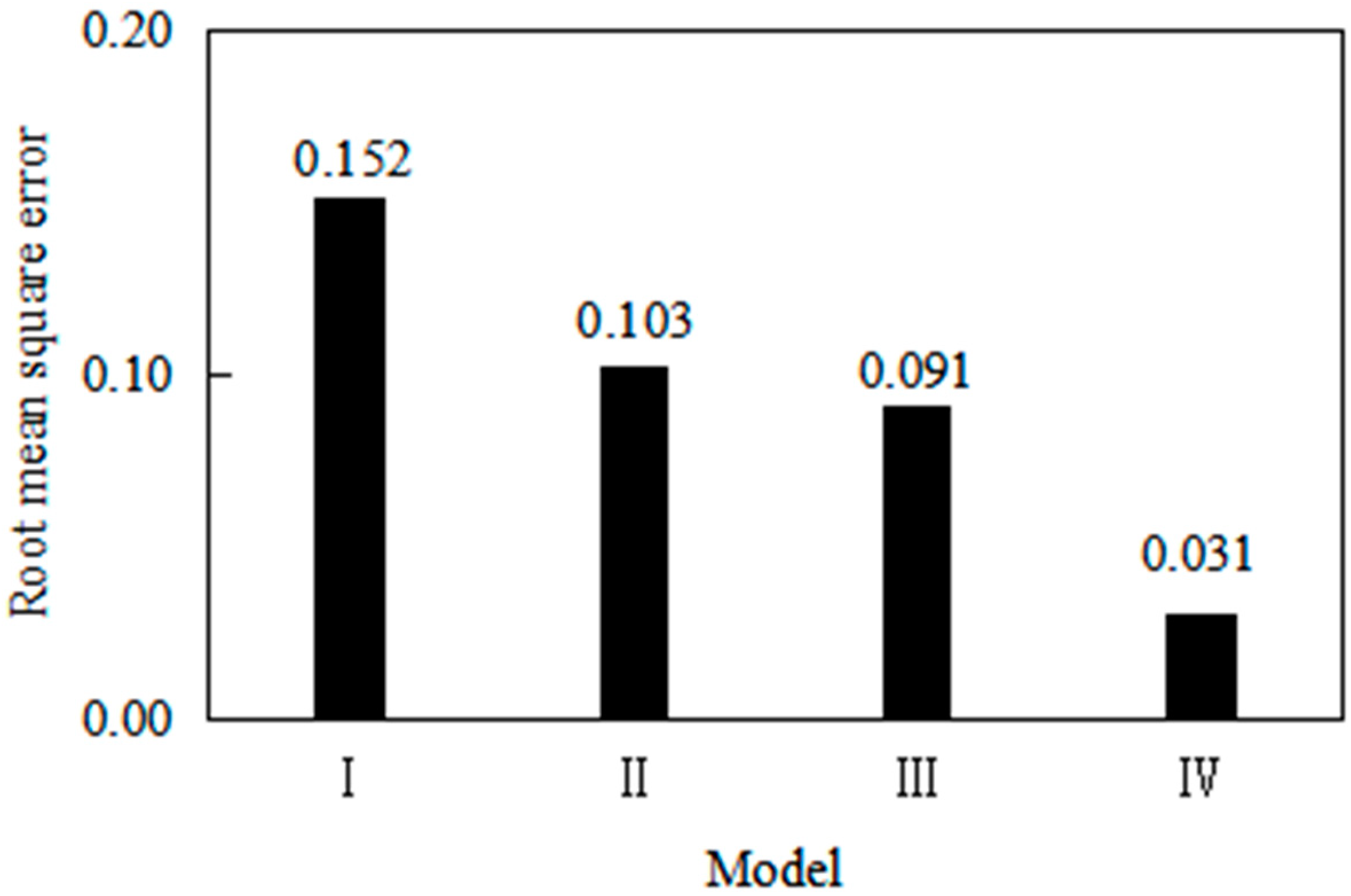Research on the Prediction of Wax Deposition Thickness on Pipe Walls Based on the Optimal Weighted Combination Model
Abstract
:1. Introduction
2. Traditional GM (1,1), Logarithmic Function Model and Improved GM (1,1)
2.1. Traditional Model
2.2. Logarithmic Function Model
2.3. Improved Model
3. Establishment of the Optimal Weighted Combination Model
3.1. Determination of Weight Coefficients Based on Optimal Weighting Method
3.2. The Establishment Steps of the Combined Model
4. Accuracy Comparison and Analysis of Various Models
4.1. Comparative and Analysis of the Accuracy of Various Models (Based on 5–9 Sets of Data to Establish Models)
4.2. Comparative and Analysis of the Accuracy of Various Models (Based on 5–10 Sets of Data to Establish Models)
5. Conclusions
- (1)
- Based on the modeling characteristics of the traditional GM (1,1), an improved GM (1,1) based on translation transformation was proposed, and the effectiveness of the improved model was verified. The results showed that the average relative error of the improved model is always lower than that of the traditional model when the number of modeling samples is different. Therefore, translation transformation method can improve the accuracy of the traditional model and broaden the application range of the gray model.
- (2)
- Based on the traditional GM (1,1) and the logarithmic function model, a new combination model was proposed, and the weight coefficient of each single model was obtained by using the optimal weighting method. The calculation results of different modeling samples showed that the optimal weighted combination model has higher fitting accuracy and prediction accuracy than the traditional model and logarithmic function model, which can be used to predict the wax deposition thickness.
- (3)
- The improved GM (1,1) and the optimal weighted combination model that are proposed in this paper provide new ideas for predicting wax deposition. In the application process, the optimal weighted combination model only needs to determine the weight coefficient of each single model, so it has the characteristic of convenient application.
Author Contributions
Funding
Data Availability Statement
Conflicts of Interest
References
- Gan, Y.Y.; Chen, L.; Zhang, J.Q.; Betancourt, S.S.; Mullins, O.C.; Yan, Z.H.; Gao, X.F.; Tian, J.; Chen, W.H.; Wang, W.F. Wax-out cryo trapping; a new trap-filling process in fluid migration to oilfields. Energy Fuels 2022, 36, 8844–8852. [Google Scholar] [CrossRef]
- Lei, Y.; Wang, H.; Li, S.S.; Liu, X.Q.; Zhu, H.R.; Gao, Y.M.; Peng, H.P.; Yu, P.F. Effect of existence state of asphaltenes on the asphaltenes-wax interaction in wax deposition. Petrol. Sci. 2023, 20, 507–514. [Google Scholar] [CrossRef]
- Gabriel, S.; Nagu, D.; Cem, S. Dynamic microscopic study of wax deposition: Particulate deposition. Energy Fuels 2021, 35, 12065–12074. [Google Scholar]
- Yang, F.; Zhao, Y.S.; Sjöblom, J.; Li, C.X.; Paso, K.G. Polymeric wax inhibitors and pour point depressants for waxy crude oils: A critical review. J. Disper. Sci. Technol. 2014, 36, 213–225. [Google Scholar] [CrossRef]
- Singh, P.; Venkatesan, R.; Fogler, H.S. Formation and aging of incipient thin film wax oil gels. AIChE J. 2000, 46, 1059–1074. [Google Scholar] [CrossRef]
- Zhou, Y.X.; Gong, J.; Wang, P.Y. Modeling of wax deposition for water-in-oil dispersed flow. Asia-Pac. J. Chem. Eng. 2016, 11, 108–117. [Google Scholar] [CrossRef]
- Wang, P.Y.; Wang, W.; Gong, J.; Zhou, Y.X.; Yang, W.; Zhang, Y. Effect of pour point on wax deposition under static cooling conditions. Asia-Pac. J. Chem. Eng. 2013, 8, 749–755. [Google Scholar] [CrossRef]
- Masoudi, S.; Sefti, M.V.; Jafari, H.; Modares, H. The hardening process and morphology of a wax deposit in a pipe flow. Petrol. Sci. Technol. 2010, 28, 1598–1610. [Google Scholar] [CrossRef]
- Chi, Y.D.; Daraboina, N.; Sarica, C. Investigation of inhibitors efficacy in wax deposition mitigation using a laboratory scale flow loop. AIChE J. 2016, 62, 4131–4139. [Google Scholar] [CrossRef]
- Lu, Y.D.; Huang, Z.Y.; Hoffmann, R.; Amundsen, L.; Fogler, H.S. Counterintuitive effects of the oil flow rate on wax deposition. Energy Fuels 2012, 26, 4091–4097. [Google Scholar] [CrossRef]
- Hoffmann, R.; Amundsen, L. Single-phase wax deposition experiments. Energy Fuels 2010, 24, 1069–1080. [Google Scholar] [CrossRef]
- Singh, P.; Venkatesan, R.; Fogler, H.S.; Nagarajan, N.R. Morphological evolution of thick wax deposits during aging. AIChE J. 2001, 47, 6–18. [Google Scholar] [CrossRef]
- Deng, J.L. Control problems of grey systems. Syst. Control Lett. 1982, 1, 288–294. [Google Scholar]
- Guo, Q.W.; Guo, B.H.; Wang, Y.G.; Tian, S.X.; Chen, Y. A combined prediction model composed of the GM (1,1) model and the BP neural network for major road traffic accidents in China. Math. Probl. Eng. 2022, 2022, 8392759. [Google Scholar] [CrossRef]
- Zhang, X.Q.; Wu, X.L.; Xiao, Y.M.; Shi, J.W.; Zhao, Y.; Zhang, M.H. Application of improved seasonal GM (1,1) model based on HP filter for runoff prediction in Xiangjiang River. Environ. Sci. Pollut. Res. 2022, 29, 52806–52817. [Google Scholar] [CrossRef]
- Yao, H.; Zhang, Q.X.; Niu, G.Y.; Liu, H.; Yang, Y.X. Applying the GM (1,1) model to simulate and predict the ecological footprint values of Suzhou city, China. Environ. Dev. Sustain. 2021, 23, 11297–11309. [Google Scholar] [CrossRef]
- Li, Z.J.; Yang, Q.C.; Wang, L.C.; Martín, J.D. Application of RBFN network and GM (1,1) for groundwater level simulation. Appl. Water Sci. 2017, 7, 3345–3353. [Google Scholar] [CrossRef]
- Chen, S.W.; Li, Z.G.; Zhou, S.X. Application of non-equal interval GM(1,1) model in oil monitoring of internal combustion engine. J. Cent. South Univ. Technol. 2005, 12, 705–708. [Google Scholar] [CrossRef]
- Hu, Y.C. Energy demand forecasting using a novel remnant GM (1,1) model. Soft Comput. 2020, 24, 13903–13912. [Google Scholar] [CrossRef]
- Wu, M.; Qiu, S.J.; Liu, J.F.; Zhao, L. Prediction model based on the Grey Theory for tackling wax deposition in oil pipelines. J. Nat. Gas Chem. 2005, 14, 243–247. [Google Scholar]
- Cheng, M.L.; Shi, G.J. Improved methods for parameter estimation of gray model GM (1,1) based on new background value optimization and model application. Commun. Stat-Simul. Comput. 2022, 51, 647–669. [Google Scholar] [CrossRef]
- Jin, W.B.; Quan, Q.; Hui, X.Z.; Chen, J.H.; Qin, G.W. Prediction of wax deposition thickness on pipe wall by improved GM (1,1) model based on data transformation method. Petrol. Sci. Technol. 2022, 40, 1551–1566. [Google Scholar] [CrossRef]
- Deng, Y.H. Improved combination GM(1, 1)model and its application in distortion inspction. Appl. Mech. Mater. 2011, 1449, 229–232. [Google Scholar] [CrossRef]
- Zhao, L.; Xu, H.K.; Cheng, H.L. Road traffic accidents prediction based on optimal weighted combined model. Comput. Eng. Appl. 2013, 49, 11–15. [Google Scholar]
- Li, D.W.; Chen, J.B.; Qiu, M.L. Research on population development trend in Huizhou of China forecast based on optimal weighted combination method and fractional grey model. J. Math. 2021, 2021, 3320910. [Google Scholar] [CrossRef]
- Su, X. Research on Wax Deposition and Pigging Periods in Submarine Waxy Crude Oil Pipeline. Master’s Thesis, Southwest Petroleum University, Chengdu, China, 2015. [Google Scholar]




| Time (h) | Thickness (mm) |
|---|---|
| 1 | 0 |
| 2 | 0 |
| 3 | 0 |
| 4 | 0 |
| 5 | 0.33 |
| 6 | 0.65 |
| 7 | 0.82 |
| 8 | 0.97 |
| 9 | 1.08 |
| 10 | 1.19 |
| 11 | 1.3 |
| 12 | 1.42 |
| Num | Test Value (mm) | Model I | Model II | Model III | Model IV | ||||
|---|---|---|---|---|---|---|---|---|---|
| Calculated Value (mm) | Relative Error (%) | Calculated Value (mm) | Relative Error (%) | Calculated Value (mm) | Relative Error (%) | Calculated Value (mm) | Relative Error (%) | ||
| 5 | 0.33 | 0.33 | 0.000 | 0.33 | 0.000 | 0.3267 | 1.000 | 0.3274 | 0.788 |
| 6 | 0.65 | 0.6794 | 4.523 | 0.6715 | 3.308 | 0.6476 | 0.369 | 0.6540 | 0.615 |
| 7 | 0.82 | 0.7977 | 2.720 | 0.8018 | 2.220 | 0.8354 | 1.878 | 0.8278 | 0.951 |
| 8 | 0.97 | 0.9367 | 3.433 | 0.9438 | 2.701 | 0.9686 | 0.144 | 0.9622 | 0.804 |
| 9 | 1.08 | 1.0998 | 1.833 | 1.0987 | 1.731 | 1.0719 | 0.750 | 1.0775 | 0.231 |
| 10 | 1.19 | 1.2914 | 8.521 | 1.2676 | 6.521 | 1.1563 | 2.832 | 1.1834 | 0.555 |
| 11 | 1.3 | 1.5163 | 16.638 | 1.4517 | 11.669 | 1.2277 | 5.562 | 1.2855 | 1.115 |
| 12 | 1.42 | 1.7805 | 25.387 | 1.6524 | 16.366 | 1.2895 | 9.190 | 1.3878 | 2.268 |
| Model | Average Relative Error (%) |
|---|---|
| Model I | 2.502 |
| Model II | 1.992 |
| Model III | 0.828 |
| Model IV | 0.678 |
| Num | Test Value (mm) | Model I | Model II | Model III | Model IV | ||||
|---|---|---|---|---|---|---|---|---|---|
| Calculated Value (mm) | Relative Error (%) | Calculated Value (mm) | Relative Error (%) | Calculated Value (mm) | Relative Error (%) | Calculated Value (mm) | Relative Error (%) | ||
| 5 | 0.33 | 0.33 | 0.000 | 0.33 | 0.000 | 0.3206 | 2.848 | 0.3229 | 2.152 |
| 6 | 0.65 | 0.6996 | 7.631 | 0.6866 | 5.631 | 0.6489 | 0.169 | 0.6613 | 1.738 |
| 7 | 0.82 | 0.8038 | 1.976 | 0.8045 | 1.890 | 0.8410 | 2.561 | 0.8319 | 1.451 |
| 8 | 0.97 | 0.9236 | 4.784 | 0.9315 | 3.969 | 0.9773 | 0.753 | 0.9642 | 0.598 |
| 9 | 1.08 | 1.0612 | 1.741 | 1.0683 | 1.083 | 1.0830 | 0.278 | 1.0777 | 0.213 |
| 10 | 1.19 | 1.2194 | 2.471 | 1.2156 | 2.151 | 1.1694 | 1.731 | 1.1816 | 0.706 |
| 11 | 1.3 | 1.4011 | 7.777 | 1.3744 | 5.723 | 1.2424 | 4.431 | 1.2811 | 1.454 |
| 12 | 1.42 | 1.6099 | 13.373 | 1.5454 | 8.831 | 1.3056 | 8.056 | 1.3798 | 2.831 |
| Model | Average Relative Error (%) |
|---|---|
| Model I | 3.101 |
| Model II | 2.454 |
| Model III | 1.390 |
| Model IV | 1.143 |
Disclaimer/Publisher’s Note: The statements, opinions and data contained in all publications are solely those of the individual author(s) and contributor(s) and not of MDPI and/or the editor(s). MDPI and/or the editor(s) disclaim responsibility for any injury to people or property resulting from any ideas, methods, instructions or products referred to in the content. |
© 2023 by the authors. Licensee MDPI, Basel, Switzerland. This article is an open access article distributed under the terms and conditions of the Creative Commons Attribution (CC BY) license (https://creativecommons.org/licenses/by/4.0/).
Share and Cite
Jin, W.; Quan, Q.; Dai, K.; Ren, Z.; Guan, J. Research on the Prediction of Wax Deposition Thickness on Pipe Walls Based on the Optimal Weighted Combination Model. Processes 2023, 11, 3363. https://doi.org/10.3390/pr11123363
Jin W, Quan Q, Dai K, Ren Z, Guan J. Research on the Prediction of Wax Deposition Thickness on Pipe Walls Based on the Optimal Weighted Combination Model. Processes. 2023; 11(12):3363. https://doi.org/10.3390/pr11123363
Chicago/Turabian StyleJin, Wenbo, Qing Quan, Kemin Dai, Zongxiao Ren, and Jing Guan. 2023. "Research on the Prediction of Wax Deposition Thickness on Pipe Walls Based on the Optimal Weighted Combination Model" Processes 11, no. 12: 3363. https://doi.org/10.3390/pr11123363





